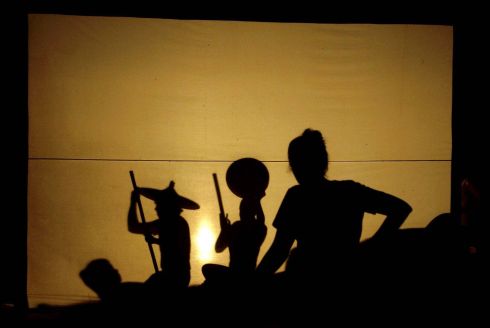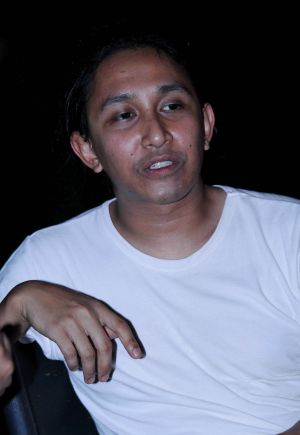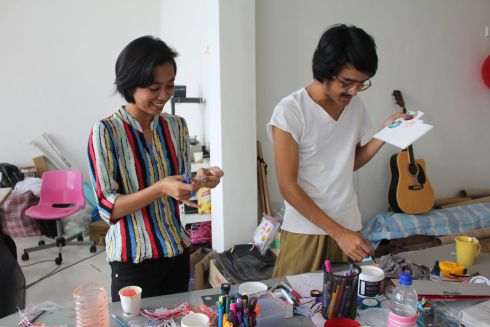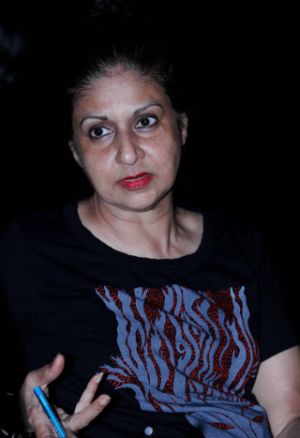There are many ways an artist tells a story, some don’t even involve words.
By SHARMILA NAIR
alltherage@thestar.com.my
THE huge white screen in the middle of the driveway of one of the houses in Bukit Tunku, Kuala Lumpur, was an indication that something interesting was going to happen that night.
On the screen, the shadow of two men rowing a boat slowly but clearly appeared. The men rowed calmly and the boat sailed accordingly.
It seemed real, until two other guys rolled away to reveal that it was them who had positioned their bodies to look like the vessel.
Impressive. In fact, very impressive, indeed.
The actors were rehearsing for Wayang … The Story Of Kuala Lumpur And Wayang1, a shadow play which is currently being staged at Auditorium Bandaraya in KL. It is about the history of the city of Kuala Lumpur and is told through visuals, and only visuals. There is no script – something that most actors would fear.
“It’s really different, acting with no script in Wayang, which is why I must say that I prefer conventional plays (with a script) as I like to hear myself talk,” said Az’farr Baginda, 28, with a laugh.
On a serious note, Az’farr said that shadow play gives actors the opportunity to tell a story using only visuals, and that is a challenge on its own.
Shadow play is an art as old as time and has been around for ages. In Malaysia, we have our very own traditional version of it – wayang kulit – but what Az’farr and his castmates are doing is something still fairly new in this country.
“Our director Sabera Shaik was the one who wanted to try shadow theatre here. She had seen it staged overseas and wanted to introduce this style of performance to us,” said Az’farr.
In shadow theatre, the actors don’t just play human characters but also contort their bodies to create the impression of buildings, animals and everything else that they need to tell a story.
With the help of a narrator, the audience is walked through each scene but some of the images that the actors create are so telling that an explanation is not needed at all. They say that a picture paints a thousand words and in the case of Wayang, it’s truly fitting.
Ahmad Ezzat Hakimi has over 10 “characters” to play in the show – and not all of them are of human.
“I’m part of a horse, a building, a car … well, let’s just say I’m part of something and everything in this play,” said the 19-year-old actor. No character is too small and whatever role they are handed, the actors play it to perfection, or at least close to it.
Here, they rely solely on their flexibility to twist their bodies to, well, become the props and use their body language to convey the story.
“I’ve done physical theatre before but for shadow play, you have to be really, really flexible. Contracting muscles, making everything bend … it’s difficult. If you don’t move in the right way, people will get the wrong message,” said Az’farr.
Creative freedom
Some may feel that the actors do not get any creative freedom in the play as they are restricted to forming certain shapes that requires precision. Az’farr and Ezzat claim otherwise.
“The director gives us so much freedom to interpret the scenes and come up with as many different ways to portray the characters. We really do get to be as creative as we want here, provided that the director agrees with what we do,” said Ezzat.
There are many ways an artist can tell a story and they don’t usually have to involve words – and that’s how Fairuz Sulaiman likes it. If you ever get stumped trying to define Fairuz’s art work, don’t fret too much. That is because the artist himself has trouble explaining what he really does and why.
Pacing up and down at his workstation in a lofty studio in Ara Damansara, Petaling Jaya, Selangor, Fairuz looked at his partner Siti Sarah Ameera for answers.
“I guess there really isn’t a definition to what we do. It’s wayang kulit, projection, graphics, animation and more.
“But whatever it is, it’s definitely live,” said Fairuz, 30.
You see, what Fairuz and Sarah do can be loosely defined as “devised moving visual art”. Imagine painting, splashing colours on canvas, doing puppetry, shadow play and more and projecting it live to an audience.
The audience get to watch on screen every single stroke, movement and creative moments as Fairuz, Sarah and their team work away behind the scene.
“This kind of artwork is not new. It’s been happening in the United States and Britain for a long time but it’s just starting to get recognised in Malaysia,” said Fairuz, who has been practising the art for over 10 years.
The team has been working diligently on creating some live visual art for local artistes such as Ferns and Liyana Fizi, and have also “performed” at several corporate events.
“The main idea of this art is that it happens live and the audience can see it as it’s happening. The fact that you can edit something makes it feel less ‘real’,” said Fairuz.
Anything that is live also means that mistakes can happen and there won’t be anything the artists could do to stop them.
“Well, we have had many happy accidents. Things just went wrong but that’s just part of the artwork then. It’s the risk we have to face,” said Sarah, 23.
However, each session is different and the fun, risk and excitement they experience is never alike.
“I just show up to shows with my ‘magician’s box’ which has everything I need and start playing with things according to the mood of the audience and the general atmosphere.
“ I don’t repeat the artwork because it’s impossible to recreate any of the past work, and besides, I don’t like it that way. Everything has to be live and original,” said Fairuz.
Gaining support
It is never easy to sustain the popularity of any art form and that responsibility unfortunately always falls on the practitioners’ hands.
Director Sabera feels that people should know that art is not just for practitioners. It belongs to everyone and that it’s a collective duty to sustain any form of it.
“Imagine a kid who doesn’t know what wayang kulit or shadow play is. That is really sad. People should be exposed to the many form of arts that are out there and more importantly, the practitioners shouldn’t give up in wanting to tell their stories,” she said.
Sabera feels the need to introduce unique art forms, such as shadow play, to Malaysians, wanting them to be on par with the other international art lovers.
“The entertainment value is there and it speaks to both the young and old. Art builds a civilised society and builds culture. It should be accepted and practised everywhere,” said Sabera.
That is a sentiment that Fairuz and Sarah share as well. It had not been easy for Fairuz, considered a pioneer of the devised visual art form here, to bring attention to his work in the earlier days.
It usually went unnoticed and in fact, they had only started getting paid for it in the last two years.
“It is not possible to sustain yourself doing just visual art. We have had to get second jobs. Sarah is a part-time lecturer.
“Don’t call me a struggling artist, though. I’m not starving and have enough food to eat. It’s the studio’s rent that I have to think about,” said Fairuz.
Wayang … The Story Of Kuala Lumpur And Wayang1 is currently staged at Auditorium Bandaraya, Kuala Lumpur, and will go on until April 18.
Book your tickets by e-mailling
masakini_theatre@hotmail.com or call 012-313 1733. Tickets are also available at the door.







Tell us what you think!